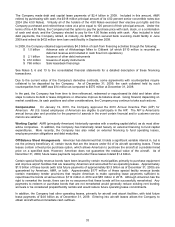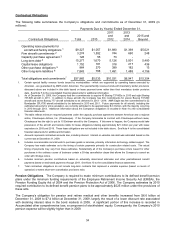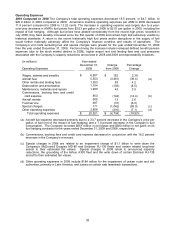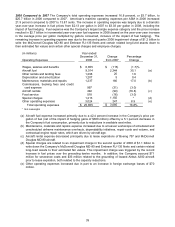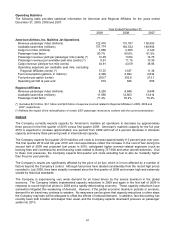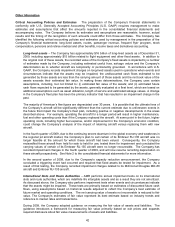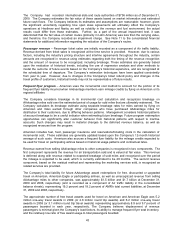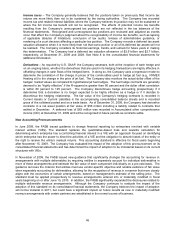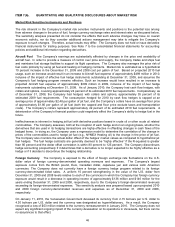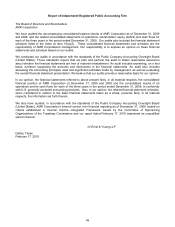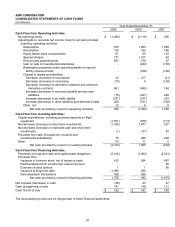American Airlines 2009 Annual Report Download - page 46
Download and view the complete annual report
Please find page 46 of the 2009 American Airlines annual report below. You can navigate through the pages in the report by either clicking on the pages listed below, or by using the keyword search tool below to find specific information within the annual report.43
The Company had recorded international slots and route authorities of $736 million as of December 31,
2009. The Company estimates the fair value of these assets based on market information and estimated
future cash flows. The Company believes its estimates and assumptions are reasonable; however, given
the significant uncertainty regarding how open skies agreements will ultimately affect the Company’s
operations at Heathrow and Narita, as well as volatility in the revenue and fuel environment, the actual
results could differ from those estimates. Further, as a part of the annual impairment test, it was
determined that the fair value of certain routes (primarily in Latin America) was less than the carrying value,
and therefore, the Company recorded an impairment charge. See Note 11 to the consolidated financial
statements for additional information regarding the valuation of the Company’s routes.
Passenger revenue – Passenger ticket sales are initially recorded as a component of Air traffic liability.
Revenue derived from ticket sales is recognized at the time service is provided. However, due to various
factors, including the industry’s pricing structure and interline agreements throughout the industry, certain
amounts are recognized in revenue using estimates regarding both the timing of the revenue recognition
and the amount of revenue to be recognized, including breakage. These estimates are generally based
upon the evaluation of historical trends, including the use of regression analysis and other methods to
model the outcome of future events based on the Company’s historical experience, and are recognized at
the scheduled time of departure. The Company’s estimation techniques have been applied consistently
from year to year. However, due to changes in the Company’s ticket refund policy and changes in the
travel profile of customers, historical trends may not be representative of future results.
Frequent flyer program – American uses the incremental cost method to account for the portion of its
frequent flyer liability incurred when AAdvantage members earn mileage credits by flying on American or its
regional affiliates.
The Company considers breakage in its incremental cost calculation and recognizes breakage on
AAdvantage miles sold over the estimated period of usage for sold miles that are ultimately redeemed. The
Company calculates its breakage estimate using separate breakage rates for miles earned by flying on
American and miles earned through other companies who have purchased AAdvantage miles for
distribution to their customers, due to differing behavior patterns. Management considers historical patterns
of account breakage to be a useful indicator when estimating future breakage. Future program redemption
opportunities can significantly alter customer behavior from historical patterns with respect to inactive
accounts. Such changes may result in material changes to the deferred revenue balance, as well as
recognized revenues from the program.
American includes fuel, food, passenger insurance and reservations/ticketing costs in the calculation of
incremental cost. These estimates are generally updated based upon the Company’s 12-month historical
average of such costs. American also accrues a frequent flyer liability for the mileage credits expected to
be used for travel on participating airlines based on historical usage patterns and contractual rates.
Revenue earned from selling AAdvantage miles to other companies is recognized in two components. The
first component represents the revenue for air transportation sold and is valued at fair value. This revenue
is deferred along with revenue related to expected breakage of sold miles and recognized over the period
the mileage is expected to be used, which is currently estimated to be 28 months. The second revenue
component, based on the residual method and representing the marketing services sold, is recognized as
related services are provided.
The Company’s total liability for future AAdvantage award redemptions for free, discounted or upgraded
travel on American, American Eagle or participating airlines, as well as unrecognized revenue from selling
AAdvantage miles to other companies, was approximately $1.5 billion and $1.7 billion at December 31,
2009 and 2008, respectively (and is recorded as a component of Air traffic liability in the consolidated
balance sheets), representing 19.2 percent and 18.2 percent of AMR's total current liabilities, at December
31, 2009 and 2008, respectively.
The approximate number of free travel awards used for travel on American and American Eagle was 5.2
million one-way travel awards in 2009 (or 2.6 million round trip awards) and 6.2 million one-way travel
awards in 2008 (or 3.1 million round trip travel awards) representing approximately 8.9 and 9.7 percent of
passengers boarded in each year, respectively. The Company believes displacement of revenue
passengers is minimal given the Company’s load factors, its ability to manage frequent flyer seat inventory,
and the relatively low ratio of free award usage to total passengers boarded.


